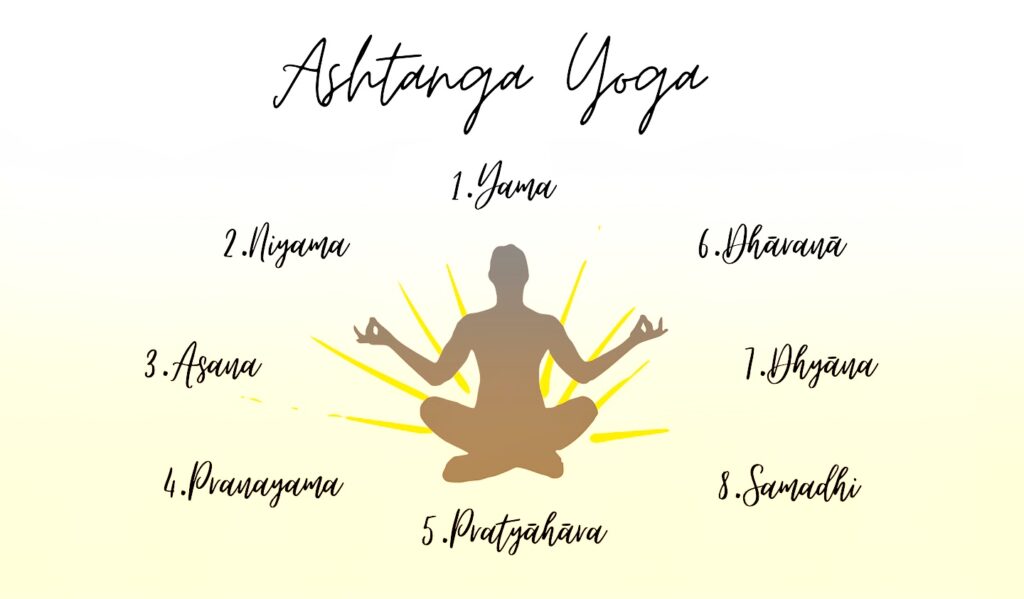In Patanjali’s yoga sutras, the eightfold path is called ashtanga yoga . It is a guide to live a meaningful and purposeful life.
eight limbs are –

1. Yama
The first limb, Yama, deals with one’s ethical standards and sense of integrity, focusing on our behaviour and how we conduct ourselves in life.
The five Yamas are :
- Ahimsa – nonviolence
- Satya – truthfulness
- Asteya – non stealing
- Brahmacharya – continence
- Aparigraha – non covetousness
2. Niyama
Niyama, the second limb, has to do with self-discipline and spiritual observances.
The five Niyamas are:
- Saucha – cleanliness
- samtosha – contentment
- Tapas – heat, spiritual austerities
- Swadhyaya – Study of the sacred scriptures and one’s self
- Isvara pranidhana – surrender to god.
3. Asana
Asanas, the posture practiced in yoga, comprise the third limb. In the yogic view, the body is a temple of spirit, the care of which is important stage of our spiritual growth. Through the practice of asanas, we develop the habit of discipline and the ability to concentrate, both of which are necessary for meditation.
4. Pranayama
Pranayama means the control of Prana (breath). This stage is consists of techniques designed to gain mastery over the respiratory process. Pranayama rejuvenates the body.
5. Pratyāhāra
Pratyāhāra is the fifth limb of Ashtanga. It means withdrawal. At this stage person practice detachment from senses, practitioner direct his attention internally. The practice of Pratyāhāra provides an opportunity to step back and take a look at ourselves. This withdrawal allow to objectively observe cravings, habits that are perhaps detrimental to health and which likely interfere with inner growth. In Pratyāhāra person become self-observant.
6. Dhāranā
At each stage prepares us for the next, the practice of Pratyāhāra creates the setting for Dhāranā. Dhāranā means holding the mind to certain points. What is meant by holding the mind to certain points? Forcing the mind to feel certain parts of body to exclusion of others. For example try to feel only hand, to the exclusion of others body parts of the body. When the chitta or mind stuff, is confined and limited to a certain place it is Dhāranā. Now in Dhāranā, we focus our attention on single point. Extended periods of concentration naturally lead to meditation (Dhyāna).
7. Dhyāna
‘Meditation or contemplation’ the seventh stage of Ashtanga. Dhyāna is the uninterrupted flow of concentration. Dharna and dhyana its not same as it appear. There is a fine line of distinction exists between two stages. Where Dhāranā practices one-pointed attention and Dhyāna is ultimately a stage being keenly aware without focus. At this stage, the mind has been quieted and in the stillness it produces few or no thoughts at all.
8. Samadhi
Patanjali describes this eighth and final stage of ashtanga yoga, as a state of ecstasy. At this stage, the meditator merges with his or her point of focus and transcends the self altogether. The meditator comes to realise a profound connection to the Divine. when one has so intensified the power of Dhyāna as to be able to reject the external part of perception and remain meditating only on the internal part, the meaning that state is called samadhi
All the different steps on Ashtanga yoga bring us scientifically to the super consciousness state or samadhi . The three Dhāranā, Dhyāna and Samadhi – together are called samyama.
MORE TOPICS
- What is prenatal yoga ? Click here
- What is Shatkarma ? Click here
- What is trataka meditation ? Click here
- Which asana is good for digestion ? Click here
